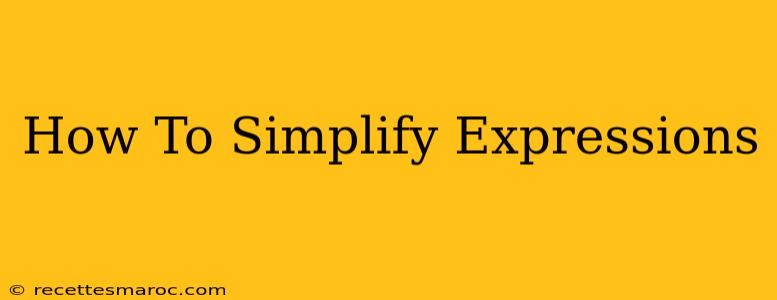Simplifying expressions is a fundamental skill in algebra and mathematics in general. It involves manipulating an expression to make it easier to understand and work with, without changing its value. This guide will walk you through various techniques to simplify expressions effectively.
Understanding the Basics
Before diving into simplification techniques, let's clarify what constitutes an algebraic expression. An algebraic expression is a combination of variables (like x, y, z), constants (numbers), and mathematical operations (+, -, ×, ÷). The goal of simplification is to rewrite the expression in a more concise and manageable form.
Key Concepts for Simplification
- Order of Operations (PEMDAS/BODMAS): This is crucial. Remember the acronym: Parentheses/Brackets, Exponents/Orders, Multiplication and Division (from left to right), Addition and Subtraction (from left to right). Always follow this order when simplifying.
- Combining Like Terms: This is the cornerstone of simplification. Like terms have the same variables raised to the same powers. For example, 3x and 5x are like terms, but 3x and 3x² are not. You can add or subtract like terms.
- Distributive Property: This property allows you to simplify expressions involving parentheses. It states that a(b + c) = ab + ac. This applies to subtraction as well: a(b - c) = ab - ac.
- Factoring: This is the reverse of the distributive property. It involves expressing an expression as a product of simpler expressions. For example, factoring x² + 5x + 6 gives (x + 2)(x + 3).
Techniques for Simplifying Expressions
Let's explore common simplification techniques with examples:
1. Removing Parentheses
If parentheses are preceded by a plus sign, you can simply remove them. If preceded by a minus sign, you change the sign of each term inside the parentheses.
Example:
(3x + 2y) + (x - y) = 3x + 2y + x - y = 4x + y
(5a - 2b) - (a + 3b) = 5a - 2b - a - 3b = 4a - 5b
2. Combining Like Terms
After removing parentheses, group and combine like terms.
Example:
7x + 3y - 2x + 5y = (7x - 2x) + (3y + 5y) = 5x + 8y
3. Applying the Distributive Property
Use the distributive property to remove parentheses when a term is multiplied by a sum or difference.
Example:
3(2x + 4) = 3(2x) + 3(4) = 6x + 12
-2(x - 5) = -2(x) - 2(-5) = -2x + 10
4. Factoring
Factoring is the reverse of the distributive property. It's used to rewrite expressions as products. This is particularly useful for solving equations and simplifying more complex expressions.
Example:
x² + 6x + 8 = (x + 2)(x + 4)
5. Simplifying Fractions
If your expression includes fractions, simplify them by canceling common factors in the numerator and denominator.
Example:
(6x²y) / (3xy) = (3x * 2xy) / (3xy * 1) = 2x (assuming x and y are not zero).
Practice Makes Perfect
The best way to master simplifying expressions is through practice. Work through numerous examples, focusing on each step. Start with simpler expressions and gradually progress to more complex ones. Don't hesitate to consult textbooks, online resources, or tutors if you get stuck. Consistent practice will build your confidence and proficiency in simplifying algebraic expressions. Remember to always double-check your work to ensure accuracy!

